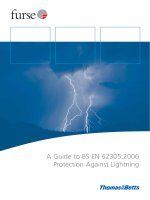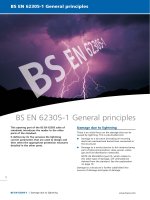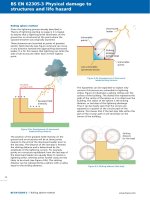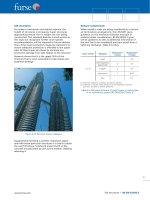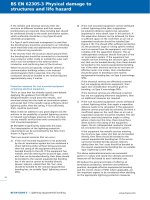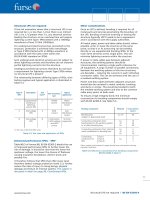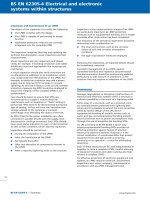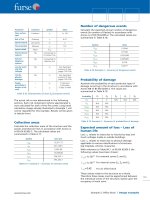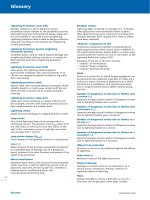Bsi bs en 00413 2 2016
Bạn đang xem bản rút gọn của tài liệu. Xem và tải ngay bản đầy đủ của tài liệu tại đây (1.82 MB, 22 trang )
BS EN 413-2:2016
BSI Standards Publication
Masonry cement
Part 2: Test methods
BS EN 413-2:2016
BRITISH STANDARD
National foreword
This British Standard is the UK implementation of EN 413-2:2016.
It supersedes BS EN 413-2:2005 which is withdrawn.
The UK participation in its preparation was entrusted to Technical
Committee B/516/10, Masonry cement.
A list of organizations represented on this committee can be
obtained on request to its secretary.
This publication does not purport to include all the necessary
provisions of a contract. Users are responsible for its correct
application.
© The British Standards Institution 2016.
Published by BSI Standards Limited 2016
ISBN 978 0 580 92162 9
ICS 91.100.10
Compliance with a British Standard cannot confer immunity from
legal obligations.
This British Standard was published under the authority of the
Standards Policy and Strategy Committee on 31 October 2016.
Amendments/corrigenda issued since publication
Date
Text affected
BS EN 413-2:2016
EN 413-2
EUROPEAN STANDARD
NORME EUROPÉENNE
EUROPÄISCHE NORM
October 2016
ICS 91.100.10
Supersedes EN 413-2:2005
English Version
Masonry cement - Part 2: Test methods
Ciment maỗonner - Partie 2 : Méthodes d'essai
Putz- und Mauerbinder - Teil 2: Prüfverfahren
This European Standard was approved by CEN on 18 June 2016.
CEN members are bound to comply with the CEN/CENELEC Internal Regulations which stipulate the conditions for giving this
European Standard the status of a national standard without any alteration. Up-to-date lists and bibliographical references
concerning such national standards may be obtained on application to the CEN-CENELEC Management Centre or to any CEN
member.
This European Standard exists in three official versions (English, French, German). A version in any other language made by
translation under the responsibility of a CEN member into its own language and notified to the CEN-CENELEC Management
Centre has the same status as the official versions.
CEN members are the national standards bodies of Austria, Belgium, Bulgaria, Croatia, Cyprus, Czech Republic, Denmark, Estonia,
Finland, Former Yugoslav Republic of Macedonia, France, Germany, Greece, Hungary, Iceland, Ireland, Italy, Latvia, Lithuania,
Luxembourg, Malta, Netherlands, Norway, Poland, Portugal, Romania, Slovakia, Slovenia, Spain, Sweden, Switzerland, Turkey and
United Kingdom.
EUROPEAN COMMITTEE FOR STANDARDIZATION
COMITÉ EUROPÉEN DE NORMALISATION
EUROPÄISCHES KOMITEE FÜR NORMUNG
CEN-CENELEC Management Centre: Avenue Marnix 17, B-1000 Brussels
© 2016 CEN
All rights of exploitation in any form and by any means reserved
worldwide for CEN national Members.
Ref. No. EN 413-2:2016 E
BS EN 413-2:2016
EN 413-2:2016 (E)
Contents
Page
European foreword....................................................................................................................................................... 4
Introduction .................................................................................................................................................................... 5
1
Scope .................................................................................................................................................................... 6
2
Normative references .................................................................................................................................... 6
3
3.1
3.2
3.2.1
3.2.2
3.3
3.4
General requirements for testing.............................................................................................................. 6
Laboratory ......................................................................................................................................................... 6
Manufacturing tolerances for test equipment ...................................................................................... 6
Dimensions ........................................................................................................................................................ 6
Mass...................................................................................................................................................................... 6
Tolerances for test equipment in use ...................................................................................................... 6
Number of tests ................................................................................................................................................ 7
4
4.1
4.2
4.3
4.3.1
4.3.2
4.3.3
4.3.4
4.3.5
4.3.6
Determination of setting time .................................................................................................................... 7
General ................................................................................................................................................................ 7
Method A............................................................................................................................................................. 7
Method B............................................................................................................................................................. 7
Test principle.................................................................................................................................................... 7
Initial setting time procedure..................................................................................................................... 7
Report – initial setting time ......................................................................................................................... 8
Final setting time procedure ....................................................................................................................... 8
Report – final setting time............................................................................................................................ 8
Repeatability and reproducibility............................................................................................................. 8
5
5.1
5.2
5.2.1
5.2.2
5.2.3
5.3
5.3.1
5.3.2
5.3.3
5.3.4
Preparation of standard mortar ................................................................................................................ 8
Principle ............................................................................................................................................................. 8
Consistence of fresh mortar by plunger apparatus (reference method) .................................... 8
Apparatus........................................................................................................................................................... 8
Procedure........................................................................................................................................................... 9
Reproducibility ................................................................................................................................................ 9
Consistence of fresh mortar by flow table (alternative method) .................................................. 9
Method ................................................................................................................................................................ 9
Apparatus........................................................................................................................................................... 9
Calibration ......................................................................................................................................................... 9
Procedure........................................................................................................................................................ 10
6
6.1
6.2
6.3
6.4
6.5
Determination of water retention.......................................................................................................... 10
Principle .......................................................................................................................................................... 10
Preparation .................................................................................................................................................... 10
Apparatus........................................................................................................................................................ 12
Procedure........................................................................................................................................................ 13
Repeatability and reproducibility.......................................................................................................... 13
7
7.1
7.2
7.2.1
7.2.2
7.2.3
Determination of air content ................................................................................................................... 14
General ............................................................................................................................................................. 14
Pressure method (reference method) .................................................................................................. 14
Principle .......................................................................................................................................................... 14
Apparatus........................................................................................................................................................ 14
Calibration ...................................................................................................................................................... 14
2
BS EN 413-2:2016
EN 413-2:2016 (E)
7.2.4
7.2.5
7.3
7.3.1
7.3.2
7.3.3
Procedure........................................................................................................................................................ 15
Repeatability and reproducibility.......................................................................................................... 15
Alcohol method (alternative method) .................................................................................................. 16
Principle .......................................................................................................................................................... 16
Apparatus........................................................................................................................................................ 16
Procedure........................................................................................................................................................ 16
Bibliography ................................................................................................................................................................. 18
3
BS EN 413-2:2016
EN 413-2:2016 (E)
European foreword
This document (EN 413-2:2016) has been prepared by Technical Committee CEN/TC 51
“Cement and building limes”, the secretariat of which is held by NBN.
This European Standard shall be given the status of a national standard, either by publication of
an identical text or by endorsement, at the latest by February 2017, and conflicting national
standards shall be withdrawn at the latest by February 2017.
Attention is drawn to the possibility that some of the elements of this document may be the
subject of patent rights. CEN shall not be held responsible for identifying any or all such patent
rights.
This document supersedes EN 413-2:2005.
This document has been prepared under a mandate given to CEN by the European Commission
and the European Free Trade Association.
EN 413, Masonry cement, consists of the following parts:
— Part 1: Composition, specifications and conformity criteria;
— Part 2: Test methods.
The main differences between this document and EN 413-2:2005 are:
— updating of normative references;
— revised guidance on the properties of gauzes used in the water retention test;
— revised repeatability and reproducibility limits for setting time(Method B), water retention
and air content (these revisions are based on a round-robin test programme instituted
following the introduction of a new class of Masonry cement MC 22,5 into EN 413-1).
According to the CEN-CENELEC Internal Regulations, the national standards organisations of
the following countries are bound to implement this European Standard: Austria, Belgium,
Bulgaria, Croatia, Cyprus, Czech Republic, Denmark, Estonia, Finland, Former Yugoslav Republic
of Macedonia, France, Germany, Greece, Hungary, Iceland, Ireland, Italy, Latvia, Lithuania,
Luxembourg, Malta, Netherlands, Norway, Poland, Portugal, Romania, Slovakia, Slovenia, Spain,
Sweden, Switzerland, Turkey and the United Kingdom.
4
BS EN 413-2:2016
EN 413-2:2016 (E)
Introduction
This European Standard includes additional test methods to those described in the EN 196
series, Methods of testing cement, that enable the performance of masonry cement to be
assessed when used in mortar for bedding masonry units and for rendering and plastering.
5
BS EN 413-2:2016
EN 413-2:2016 (E)
1 Scope
This European Standard describes reference and alternative test methods to be used when
testing masonry cements to assess their conformity to EN 413-1. It gives the tests on fresh
mortar for consistence, water retention and air content.
In the event of a dispute, only the reference methods are used.
2 Normative references
The following documents, in whole or in part, are normatively referenced in this document and
are indispensable for its application. For dated references, only the edition cited applies. For
undated references, the latest edition of the referenced document (including any amendments)
applies.
EN 196-1, Methods of testing cement - Part 1: Determination of strength
EN 196-3:2005+A1:2008, Methods of testing cement - Part 3: Determination of setting times and
soundness
EN 459-2:2010, Building lime - Part 2: Test methods
3 General requirements for testing
3.1 Laboratory
Unless specifically stated to the contrary, all the tests described in this document shall be
carried out in a laboratory where the air temperature is maintained at (20 ± 2) °C and the
relative humidity at not less than 50 %.
3.2 Manufacturing tolerances for test equipment
3.2.1 Dimensions
Figures indicating the specified requirements for apparatus used in the tests described in this
document shall include essential dimensions for which manufacturing tolerances are given.
Unless otherwise stated, tolerance class m according to EN 22768-1 should be applied.
NOTE
Other dimensions are given for guidance.
3.2.2 Mass
Specified masses shall have manufacturing tolerances within ± 1 % of the mass unless
otherwise stated.
3.3 Tolerances for test equipment in use
Tolerances applying to apparatus, which has been subjected to wear in use shall not exceed
twice the corresponding manufacturing tolerance unless alternative requirements are specified.
6
BS EN 413-2:2016
EN 413-2:2016 (E)
3.4 Number of tests
Where the test is one of a series subject to statistical control, determination of each property by
a single test shall be the minimum required.
Where the test is not part of a series subject to statistical control, two tests shall be performed
to determine each property.
4 Determination of setting time
4.1 General
The setting time is determined by observing the penetration of a needle into a cement paste of
standard consistence until it reaches a specified value.
The setting time is determined in accordance with either method A (4.2) or method B (4.3).
Method B is the reference method.
4.2 Method A
The setting time is determined in accordance with EN 196-3.
NOTE
Experience has shown that the method specified in EN 196–3, in which the specimens are
tested under water, is not suitable for some masonry cements which have low clinker contents.
4.3 Method B
4.3.1 Test principle
The equipment used and the specimen preparation procedures are as described in EN 196-3 but
with the additional requirement for a room or a humidity cabinet of adequate size and
maintained at (20 ± 1) °C and not less than 90 % relative humidity.
4.3.2 Initial setting time procedure
Calibrate the Vicat apparatus with the needle, attached in advance of the test, by lowering the
needle to rest on the base-plate to be used and adjusting the pointer to read zero on the scale.
Raise the needle to the stand-by position. Fill a Vicat mould in accordance with
EN 196-3:2005+A1:2008, 5.2.2 with paste of standard consistence mixed in accordance with
EN 196-3:2005+A1:2008, 5.2.1
Place the filled mould and base-plate in the room or humidity cabinet and after a suitable time,
position the mould and base-plate under the needle of the Vicat apparatus. Lower the needle
gently until it is in contact with the paste. Pause in that position for between 1 s and 2 s in order
to avoid initial velocity or forced acceleration of the moving parts. Then release the moving
parts quickly and allow the needle to penetrate vertically into the paste. Read the scale when
penetration has ceased, or 30 s after the release of the needle, whichever is the earlier.
Record the scale reading, which indicates the distance between the end of the needle and the
base-plate, together with the time from zero. Repeat the penetration on the same specimen at
conveniently spaced positions, not less than 8 mm from the rim of the mould or 5mm from each
other and at least 10 mm from the last penetration position, at conveniently spaced intervals of
time, e.g. at 10 min intervals. Between penetrations keep the specimen in a room or humidity
cabinet. Clean the Vicat needle immediately after each penetration. Retain the specimen if
determination of the final setting time is to be made.
7
BS EN 413-2:2016
EN 413-2:2016 (E)
4.3.3 Report – initial setting time
Report the elapsed time measured from zero to the time at which the distance between the
needle and the base-plate is (6 ± 3) mm as the initial setting time of the cement to the nearest 5
min.
If the initial setting time exceeds 6h determine the final setting time.
4.3.4 Final setting time procedure
Invert the filled mould and follow the procedure described in EN 196-3:2005+A1:2008, 6.3 with
the specimen held in the room or humidity cabinet at controlled humidity rather than under
water.
4.3.5 Report – final setting time
Report the elapsed time measured from zero to that at which the needle first penetrates only
0,5 mm into the specimen as the final setting time of the cement, to the nearest 15 min.
4.3.6 Repeatability and reproducibility
The standard deviation of repeatability is 4 min for initial setting time and 7 min for final setting
time.
The standard deviation of reproducibility is 20 min for initial setting time and 24 min for final
setting time.
These precision data take into account uncertainty of measurement.
5 Preparation of standard mortar
5.1 Principle
The properties of fresh mortar made with masonry cement are assessed on standard mortar
prepared in accordance with EN 196-1, but with the water content necessary for the standard
consistence.
The consistence is measured using the plunger apparatus (see 5.2) as the reference method to
achieve the required value of penetration.
A flow table test (see 5.3) is allowed as an alternative to the plunger test but it is important that
the flow table spread equivalent to the required value of penetration is established, using the
same type of masonry cement as that which shall be tested.
5.2 Consistence of fresh mortar by plunger apparatus (reference method)
5.2.1 Apparatus
The mixer and ancillary equipment shall be as described in EN 196-1.
The plunger apparatus shown in Figure 1 shall conform to the dimensions specified.
The shape of the baseplate (1) shall enable the mortar container (8) to be placed centrally
below the plunger (7). The plunger shall have a hemispherical lower end, be resistant to
corrosion and not attacked by mortar. The total mass of the rod (6) and plunger (7) shall be
(90 ± 2) g. A release mechanism (5) holds the measuring rod in its initial position so that the
lower end of the plunger is (100 ± 0,5) mm above the mortar surface prior to commencing the
test (the initial position in 5.2.2).
The tamper (see Figure 2) shall consist of a round rod made of impermeable material with sheet
metal protection and shall weigh (250 ± 15) g.
8
BS EN 413-2:2016
EN 413-2:2016 (E)
5.2.2 Procedure
Prepare the mortar according to the procedure described in EN 196-1 except that the water
content shall be that determined to give the consistence required.
Before the start of each test wipe the plunger with a damp cloth.
Fill the container in two layers immediately after completing the mixing procedure. Compact
each layer with 10 light strokes of the tamper.
Strike off the excess mortar, within 1 min of completion of mixing, by a gentle sawing action
using the straightedge held at an angle of about 45 degrees. Then at a slightly flatter angle
smooth the surface in a single direction in the reverse direction. After placing the container on
the base-plate, release the plunger from its initial position (150 ± 15) s after the completion of
mixing and determine the value of penetration into the mortar by reading the scale.
A value of penetration of (35 ± 3) mm is required for the mortar to be of standard consistence. If
the mortar does not achieve the standard consistence required then mix a new batch of mortar
using a different quantity of water. Repeat the test on new batches of mortar until the value of
penetration of (35 ± 3) mm is obtained in two consecutive tests.
Record the mass of water required in grams to obtain standard consistence and the value of
penetration in millimetres.
5.2.3 Reproducibility
The reproducibility which can be expected, expressed as the standard deviation of the results of
the penetration test obtained by different, well-experienced, laboratories is 3,0 mm.
5.3 Consistence of fresh mortar by flow table (alternative method)
5.3.1 Method
NOTE
The flow table method has been retained as an alternative to the plunger method (reference
method) as it is still widely used.
5.3.2 Apparatus
5.3.2.1
Flow table, as described in EN 459-2:2010, 6.8.2.1.2.
5.3.3 Calibration
Calibrate the flow table, using the same type of masonry cement as that to be tested, against the
plunger used for the consistence test described in 5.2. Carry out a minimum of three pairs of
tests at different water contents in order to establish the spread range on the flow table which is
equivalent to a (35 ± 3) mm value of penetration using the plunger apparatus. Then adopt this
spread in order to achieve the defined level of consistence required. The relationship between
the values using the flow table and the plunger apparatus shall be established for all products
and updated at least once every 12 months.
It is recommended to establish a relationship between flow and penetration over the range
30mm to 40mm penetration.
9
BS EN 413-2:2016
EN 413-2:2016 (E)
5.3.4 Procedure
Before the start of each test, ensure that the plate and inner surface of the mould are clean and
dry.
If the flow table has not been used during the hour prior to the test, the empty table shall be
jolted several times. There shall be neither fluid nor dirt between the bearing (6) and the boss
(8) (see EN 459-2:2010, Figure 16).
In order to determine the flow diameter, place the mould in the centre of the clean, dry surface
of the flow table (5.3.2.1). Fill it with two layers of mortar (prepared just before in accordance
with 5.2.2) during which operation the mould with the mounted hopper shall be held firmly
onto the plate with one hand in such a way that its edge coincides with the circle engraved on
the plate. Spread each layer of mortar by tamping it lightly 10 times with the tamper (Figure 2)
so that the mould is filled uniformly.
Remove the hopper without delay, and strike off the excess mortar, within 1 min of completion
of mixing, by a gentle sawing action using the straightedge held at an angle of about 45 degrees.
Then at a slightly flatter angle smooth the surface in a single direction in the reverse direction.
Clean the flow table and remove any water in the proximity of the mould. After 10 s to 15 s have
elapsed from the time the mortar has been struck off, lift the mould slowly and vertically from
the plate (150 ± 15) s after the completion of mixing. Spread the mortar by jolting the plate
15 times at one jolt per second. Measure the diameter of the pat with a calliper in two directions
at right angles to one another. Report the mean value of these measurements to 1 mm as the
flow.
A value of flow corresponding to a plunger penetration of (35 ± 3) mm is required for the
mortar to be of standard consistence. If the mortar does not achieve the standard consistence
required then mix a new batch of mortar using a different quantity of water. Repeat the test on
new batches of mortar until the required value of flow is obtained.
Record the mass of water required in grams to obtain standard consistence and the value of
flow in millimetres.
6 Determination of water retention
6.1 Principle
The fresh mortar, of standard consistence, is subjected to a suction treatment under defined
conditions using filter paper as a substrate. The water retention of the mortar is the mass of
water retained in the mortar after the suction treatment and is expressed as a percentage by
mass of its original water content.
6.2 Preparation
Having completed the consistence test described in 5.2 or 5.3, remix the mortar remaining in
the mixing bowl on low speed for 15 s and then carry out the water retention test. Should the
time interval between the commencement of mixing and the start of the suction period of the
water retention test exceed 10 min, then a fresh batch of mortar shall be prepared.
10
BS EN 413-2:2016
EN 413-2:2016 (E)
Dimensions and tolerances in millimetres
Key
1
base-plate
2
support
3
holder
The use of apparatus in which the height of the holder above the base-plate can be varied, is
acceptable, provided that for tests to this standard the height shall be set to the value specified in
Figure 1
4
guide bushes
5
release mechanism
6
aluminium measuring rod (scale with 1 mm graduations)
7
plunger
8
container (with drip protection)
Figure 1 — Plunger apparatus for measuring consistence
11
BS EN 413-2:2016
EN 413-2:2016 (E)
Dimensions and tolerances in millimetres
Figure 2 — Tamper
6.3 Apparatus
6.3.1
6.3.2
6.3.3
6.3.4
Rigid mould of (100 ± 1) mm internal diameter and (25 ± 1) mm internal depth.
Metal straightedge, as described in EN 196-1.
Mass, 2 kg.
Rigid plate, non-porous (110 ± 5) mm diameter, (5 ± 1) mm thick.
6.3.5 Cotton gauze or non-woven tissue 1) two circles (110 ± 1) mm diameter or two squares
of (110 ± 1) mm side, of nominal area weight 20 to 90 g/m2 dry gauze or tissue, each piece
having a nominal thickness of 0,06mm to 0,19mm and nominal permeability to air of
1 000 to 2 500 l/m2s.
6.3.6
Balance, with a capacity of at least 2 kg and capable of weighing to 0,1 g.
6.3.7 Filter paper, eight circles, (110 ± 1) mm diameter of 180 g/m2 to 200 g/m2 dry paper,
each circle having a nominal thickness of 0,40 mm and having a nominal particle retention size
of 6 μm. Discard all used filter papers.
6.3.8
Palette knife, with a blade 150 mm to 200 mm long and 20 mm to 30 mm wide.
1) Information on the supply of filter paper and non-woven tissue can be obtained from DIN Deutches Institut for
Normung e.V , Burggrafenstrasse 6, D-10787 Berlin, or AENOR Spanish Association for Standardisation and
Certification, Genoa 6, Madrid, 28004 Spain.
12
BS EN 413-2:2016
EN 413-2:2016 (E)
6.4 Procedure
Weigh the empty and dry mould (6.3.1) to the nearest 0,1 g (u). Weigh the eight circles of
unused filter paper to the nearest 0,1 g (v).
Fill the mould with the mortar in about 10 increments using the end of the palette knife until the
mortar is slightly above the edge of the mould. Strike off the excess mortar by a gentle sawing
action using the straightedge held at an angle of about 45°. Then at a slightly flatter angle
smooth the surface in a single direction in the reverse direction.
Weigh the mould and its contents to the nearest 0,1 g (w). Cover the surface of the mortar with
the two pieces of cotton gauze and place the eight circles of filter paper on top of the gauze.
Place the non-porous plate on top of the filter papers, invert the mould on to a flat surface and
place the 2 kg mass on the inverted base of the mould.
After (300 ± 5) s remove the 2 kg mass, re-invert the assembly, remove the rigid non-porous
plate, filter papers and the cotton gauze and weigh the filter papers to the nearest 0,1 g (x).
Calculate the mass of mortar involved in the test as (w – u), then the mass of water present (z),
from:
y(w − u)
1350 + 450 + y
z=
where:
u
(1)
is the mass of the empty mould, in grams;
w
is the mass of the mould and its contents, in grams;
y
is the mass of the water used to produce mortar having a penetration of (35 ± 3) mm, in
grams.
The mass of water taken up by the filter papers is given by (x – v).
Calculate the water retention as a percentage by mass of the total water from:
R=
where:
v
x
[ z − ( x − v )]100
z
(2)
is the mass of the eight filter papers before absorption, in grams;
is the mass of the eight filter papers after absorption, in grams;
z is the mass of water present in the mortar before absorption, in grams.
Where the test is not part of a series subject to statistical control and two individual test results
differ by more than twice the standard deviation of repeatability (1 %), repeat the test and take
the mean of the two closest test results. Report the water retention value, which is expressed to
the nearest 1 %.
6.5 Repeatability and reproducibility
The standard deviation of repeatability is 0,5 %.
The standard deviation of reproducibility is 3,1 %.
These precision data take into account uncertainty of measurement.
13
BS EN 413-2:2016
EN 413-2:2016 (E)
7 Determination of air content
7.1 General
Two methods for determining the air content are included in this document. The pressure
method (7.2) is the reference method and the alcohol method is the alternative method (7.3).
Other methods may also be used provided that prior to use they have been shown to give
similar results to the reference method.
This test shall be carried out on a fresh batch of mortar of standard consistence prepared as in
5.2.2.
7.2 Pressure method (reference method)
7.2.1 Principle
The air content of the fresh mortar is determined from the reduction in volume when a pressure
is applied.
7.2.2 Apparatus
The test apparatus (see Figure 3) consists of a metal cylinder (sample container) with a capacity
of (0,75 ± 0,05) l or (1,00 ± 0,05) l 2). The sample container (1) and the cover (2) are sealed
airtight together by means of clamps (3). The valve (7) is provided to enable filling with water
and venting of air. The air is compressed by means of a pump (4).
The pressure gauge (8) has a scale to measure the air content with divisions not greater than
0,5 %.
7.2.3 Calibration
Calibration shall be carried out, in addition to the manufacturer's instructions, in accordance
with the following procedure:
a) Measure and record the total weight of the air content meter on a dry basis.
b) Fill the air content meter 100 % with water, close the valve and take a calibration reading at
zero air content.
c) Measure and record the total weight of the air content meter as filled in b).
d) Calculate the difference between c) and a), d.
e) Take calibration readings at 5 approximately equally spaced values within an approximate
range of 5% to 25% air content using the calculated difference, d.
The calibration test values obtained shall be used in conjunction with the pressure gauge
readings to derive a relationship that can be used to correct the values when read from the
pressure gauge (see 7.2.4).
2) It may be necessary when using the 1,00 l container to increase the size of the batch of mortar.
14
BS EN 413-2:2016
EN 413-2:2016 (E)
7.2.4 Procedure
Record the weight of the empty sample container (a).
Immediately after mixing has been completed, place the mortar into the sample container in
two approximately equal layers. The final layer of mortar shall slightly overfill the sample
container. To remove air bubbles lightly touch each layer using 10 strokes of the tamper
(Figure 2), evenly distributed over the surface of the mortar. Strike off the mortar level with the
top edge of the container as described in 6.4.
Wipe the edge of the container clean with a moist cloth or with a sponge.
Record the weight of the filled container (b)
The air content shall be determined between 5 and 10 min after the test mortar has been mixed.
Place the cover (2) onto the container. Seal the cover and the container airtight together by
closing the clamps (3).
Allow both the valves (5) and (7) to remain open.
Use a squeeze bottle to squirt water into the valve (7) until all air still remaining in the meter
has been evacuated through the overflow valve (5) [the water which flows out through the valve
(5) shall be without air bubbles].
Operate the air pump until the pressure indicator has reached the initial prescribed level.
Should the pressure fall slightly after a few seconds, increase the pressure by pumping again
until the pressure indicator has again reached the mark. If the indicator goes past the mark then
this shall be corrected by partially opening correction valve (6) until the pressure indicator has
returned exactly to the mark.
Shut both valves (5) and (7). Open the correction valve (6) until the pressure equalization has
been achieved. Tap lightly on the gauge until the indicator comes to rest and read the air content
of the mortar as indicated. Correct this reading using the calibration relationship derived in
7.2.3.
After testing, open both valves (5) and (7) slowly to relieve the pressure in the sample container
(1) and then repeat the test.
Where the test is not part of a series subject to statistical control and two individual test results
differ by more than twice the standard deviation of repeatability (0,5 %), repeat the test and
take the mean of the two closest test results.
The plastic density of the mortar is calculated from the difference between (a) and (b) divided
by the nominal volume of the container (7.2.2).
Report the plastic density, which is expressed to the nearest 10 kg/m3.
Report the air content value, which is expressed to the nearest 0,5 %.
Variations to this procedure may be found between apparatus supplied by different
manufacturers. However, the manufacturers’ instructions have to be followed to obtain a
calibration as required in 7.2.3.
7.2.5 Repeatability and reproducibility
The standard deviation of repeatability is 0,5 %.
The standard deviation of reproducibility is 1,0 %.
These precision data take into account uncertainty of measurement.
15
BS EN 413-2:2016
EN 413-2:2016 (E)
7.3 Alcohol method (alternative method)
7.3.1 Principle
The air content of the mortar is determined from the reduction in volume which occurs when
the air is expelled by a liquid.
7.3.2 Apparatus
7.3.2.1
Measuring cylinder, approximately 50 mm in diameter, with a capacity of 500 ml
and with 5 ml graduations.
7.3.2.2
7.3.2.3
7.3.2.4
Rubber bung, fitting the measuring cylinder.
Funnel, fitting the measuring cylinder and suitable for filling it with mortar.
Mixture, of 60 % by volume alcohol (ethanol) and 40 % by volume water.
A sufficient quantity of 2-octanol may be used in place of ethanol.
7.3.3 Procedure
Place approximately 200 ml of mortar into the cylinder using the funnel, taking care to avoid
cavities in the mortar. Tap the cylinder to level the mortar surface and release entrapped air.
Record the mortar volume (Vm) to the nearest millilitre. Pour the mixture of alcohol and water
carefully into the cylinder up to the 500 ml mark.
Seal the cylinder with the rubber bung and invert 20 times to obtain a complete dispersion of
the mortar in the alcohol-water mixture. Let the dispersion settle for (5,0 ± 0,5) min and read
the resulting liquid level to the nearest millilitre. Repeat this process until two successive
readings do not differ by more than 1 ml. With this liquid level (Vv) calculate the air content (A)
of each mortar sample as a percentage of the original mortar volume from the following formula
to the nearest 0,1 %:
A = [(500 – Vv)/Vm] 100
where
Vm
Vv
(3)
is the volume of mortar, in millilitres;
is the volume of mortar plus liquid after shaking, in millilitres.
Calculate the average value of the two individual air contents to the nearest 0,5 %. If the two
individual values deviate more than 10 % relatively from their average value, test two
additional samples and calculate a new average value. Report the result as the air content to the
nearest 0,5 %.
16
BS EN 413-2:2016
EN 413-2:2016 (E)
Key
1
2
3
4
5
6
7
8
9
sample container
cover
clamp
pump
discharge valve
correction valve
ball valve
pressure gauge
pressure chamber
Figure 3 — Schematic diagram of an air content meter
17
BS EN 413-2:2016
EN 413-2:2016 (E)
Bibliography
[1]
EN 196 series, Methods of testing cement
[3]
EN 22768-1, General tolerances - Part 1: Tolerances for linear and angular dimensions
without individual tolerance indications (ISO 2768-1:1989)
[2]
[4]
18
EN 413-1, Masonry cement - Part 1: Composition, specifications and conformity criteria
ISO 5725-2, Accuracy (trueness and precision) of measurement methods and results —
Part 2: Basic method for the determination of repeatability and reproducibility of a
standard measurement method
This page deliberately left blank
NO COPYING WITHOUT BSI PERMISSION EXCEPT AS PERMITTED BY COPYRIGHT LAW
British Standards Institution (BSI)
BSI is the national body responsible for preparing British Standards and other
standards-related publications, information and services.
BSI is incorporated by Royal Charter. British Standards and other standardization
products are published by BSI Standards Limited.
About us
Reproducing extracts
We bring together business, industry, government, consumers, innovators
and others to shape their combined experience and expertise into standards
-based solutions.
For permission to reproduce content from BSI publications contact the BSI
Copyright & Licensing team.
The knowledge embodied in our standards has been carefully assembled in
a dependable format and refined through our open consultation process.
Organizations of all sizes and across all sectors choose standards to help
them achieve their goals.
Information on standards
We can provide you with the knowledge that your organization needs
to succeed. Find out more about British Standards by visiting our website at
bsigroup.com/standards or contacting our Customer Services team or
Knowledge Centre.
Buying standards
You can buy and download PDF versions of BSI publications, including British
and adopted European and international standards, through our website at
bsigroup.com/shop, where hard copies can also be purchased.
If you need international and foreign standards from other Standards Development
Organizations, hard copies can be ordered from our Customer Services team.
Copyright in BSI publications
All the content in BSI publications, including British Standards, is the property
of and copyrighted by BSI or some person or entity that owns copyright in the
information used (such as the international standardization bodies) and has
formally licensed such information to BSI for commercial publication and use.
Save for the provisions below, you may not transfer, share or disseminate any
portion of the standard to any other person. You may not adapt, distribute,
commercially exploit, or publicly display the standard or any portion thereof in any
manner whatsoever without BSI’s prior written consent.
Storing and using standards
Standards purchased in soft copy format:
• A British Standard purchased in soft copy format is licensed to a sole named
user for personal or internal company use only.
• The standard may be stored on more than 1 device provided that it is accessible
by the sole named user only and that only 1 copy is accessed at any one time.
• A single paper copy may be printed for personal or internal company use only.
Standards purchased in hard copy format:
• A British Standard purchased in hard copy format is for personal or internal
company use only.
• It may not be further reproduced – in any format – to create an additional copy.
This includes scanning of the document.
If you need more than 1 copy of the document, or if you wish to share the
document on an internal network, you can save money by choosing a subscription
product (see ‘Subscriptions’).
Subscriptions
Our range of subscription services are designed to make using standards
easier for you. For further information on our subscription products go to
bsigroup.com/subscriptions.
With British Standards Online (BSOL) you’ll have instant access to over 55,000
British and adopted European and international standards from your desktop.
It’s available 24/7 and is refreshed daily so you’ll always be up to date.
You can keep in touch with standards developments and receive substantial
discounts on the purchase price of standards, both in single copy and subscription
format, by becoming a BSI Subscribing Member.
PLUS is an updating service exclusive to BSI Subscribing Members. You will
automatically receive the latest hard copy of your standards when they’re
revised or replaced.
To find out more about becoming a BSI Subscribing Member and the benefits
of membership, please visit bsigroup.com/shop.
With a Multi-User Network Licence (MUNL) you are able to host standards
publications on your intranet. Licences can cover as few or as many users as you
wish. With updates supplied as soon as they’re available, you can be sure your
documentation is current. For further information, email
Revisions
Our British Standards and other publications are updated by amendment or revision.
We continually improve the quality of our products and services to benefit your
business. If you find an inaccuracy or ambiguity within a British Standard or other
BSI publication please inform the Knowledge Centre.
Useful Contacts
Customer Services
Tel: +44 345 086 9001
Email (orders):
Email (enquiries):
Subscriptions
Tel: +44 345 086 9001
Email:
Knowledge Centre
Tel: +44 20 8996 7004
Email:
Copyright & Licensing
Tel: +44 20 8996 7070
Email:
BSI Group Headquarters
389 Chiswick High Road London W4 4AL UK
